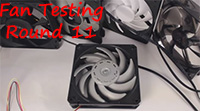Welcome to my review of the all new DT 5NOZ CPU waterblock. This is the first block tested on my brand new i7-3930K platform. Some of the veteran water coolers may recall Detroit Thermo pioneering the D5 pump top DT produced a while back which was the first D5 pump top that actually outperformed the factory top. DT is now producing an all new CPU block that is quite a bit different from the norm regarding it’s nozzle. While most of the current top blocks are utilizing a single slot nozzle over a bed of microchannels, the 5Noz is different. Erik from DT asked that I keep the internals private in this review so I’m going to have to leave you with external photos only. If you really want to see the internal nozzle, you will have to buy one.
I would like to give special thanks to Erik from http://www.dtwaterblocks.com/ for the preview sample. The sample I received was more of a preview sample which doesn’t include the more current version replaces the standard M4 nuts with large thumb-nuts as most have requested.

DETROIT AC’s PRODUCT ANNOUNCEMENT
DT 5Noz waterblock
Hello, let me present my new waterblock. I call it the 5Noz, as there is an unique nozzle inside the block with 5 openings.Martin was good enough to take these excellent pictures for me, thank you Martin!
I machine this block myself on my CNC.
I use copolymer acetal for the top and the spider. With each, I flycut the top with a slow speed and fast feed which gives it checkering like a gun grip. Because it’s a circular cutter, the pattern changes over the top and spider, very coarse near the center and fine near the edges. G 1/4 ports, of course, spaced very widely apart, so I don’t think there will be any fitting issues. There is a spotface at each fitting for proper O-ring sealing (can’t seal on the textured surface). Internally, the top has a couple of horseshoe shaped features that poke-yoke the nozzle so you can only install it in the correct orientation. The O-ring is kept round, which means super short cycle time for me to machine, but it’s also not fiddly to deal with, easy to reinstall if you need to.
The top and spider are also available in white acetal, I have parts finished but no good pictures yet.
The spider is removable and is available in Intel pattern, AMD pattern shortly, and this could be replaced for future socket designs. The spider has a pocket that the springs go down into. This hides the springs a little bit, but also the thickness of the material underneath the springs will allow a metal spider to be used instead of acetal.
The base is 110 alloy copper, 44 microchannels are machined in two steps 0.020 inches and then 0.012 inches. The base contact surface is machined flat and smooth, and is not polished. M4 female threads are in the base, which means that during disassembly for cleaning you only deal with metal threads, so less likely to strip something. The M4 stainless steel cap screws use the full head, so the hex wrench is a nice big 3mm size, less likely to be rounded out.
The nozzle is machined from 360 alloy brass and allows a unique flow path through this block. The nozzle is one of the best looking parts of this block, I wish I could share it, but it’s good and it’ll likely be…adopted…:rolleyes: The nozzle allows a flow path that contacts more fin leading edges, parallel flow paths, and provides a lower pressure drop. The base is bowed by the nozzle. One side of the nozzle is flat, and the base contact face of the nozzle is machined into a convex surface. Close tolerances must be held on the base, top and nozzle to get the bow to the 0.005 inches it’s designed for. To do this, I have to match the parts as they are built, as there are a few thou’ that parts when combined can drift. This means that it will be possible to custom assemble to any amount of bow. I think 0.005 bow is about right, but but I also think bigger IHS processors might do better with less bow, and smaller might do better with more :shrug: In any case, any amount of bow within reason can be specified.
The backplate is machined from 6061-T6 aluminum, and has machined chamfers to accept the heads of flathead M4 screws. This keeps the backplate and screws from slipping around when installing it to the mobo. There is a chamfer for LGA775, one for 115x, and one for 1366/2011. LGA2011 hardware is included, all hardware is stainless steel except for the springs which are zinc coated steel.
I’ve tested the 5Noz and the Koolance CPU-370 in my test loop.
D5 Pump with DT top, setting 5, 12V
Single 120mm radiator
Single Yate Loon D12SM-12 fan, 12V
Q6600 die simulator (copper block machined to Q6600 die sizes, Q6600 IHS soldered to these die)
200W applied to cartridge heaters in the die simulator5Noz => 31.9C temperature delta between die simulator thermocouple and air entering the radiator
CPU-370 => 33.4C delta5Noz => 2.55 GPM
CPU-370 => 1.27 GPMSamples are with a few excellent, non-biased reviewers. Hopefully you can get some independent reviews of this block shortly.

Wow … need to investigate this baby more
[…] Martin, fra Martinsliquidlab, har haft testet blokken, og som dette billed tydeligt viser, så er der virkelig tale om et kølehoved med lav modstand, der uden problemer kan følge med de store konkurrenter. Martin har skiftet platform til LGA2011 og derfor er der omkring køleevnen ikke så mange at sammenligne med, men ingen tvivl omkring at dette er et top kølehoved – Hans test kan læses her. […]
[…] Here’s some results from Martin’s testing: […]